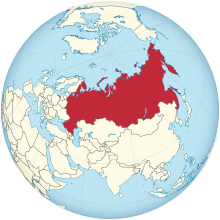Area state
An area state is a state with a comparatively large national territory , not necessarily also with a large population (so-called large state ). Opposite are the small states .
General
Territorial states are the object of knowledge in political science and geography , but a general definition of the term territorial state cannot be found here. The specialist literature is based on territorial states with a population of more than 15 million inhabitants, the area must exceed 5,000 km². In 1972 Erich Obst categorized them as macrotopic (area states with more than 800,000 km²), mesotopic (between 40,000 and 800,000 km²) and minitopic states (up to 1000 km²) ( micro-states ). The scientific interest has always been in the great states; these are states with large national territories and high populations.
Area states worldwide
With regard to their national territory, all states can be divided into large states with continental dimensions ( Russia , Canada , USA , China , Brazil and Australia ), territorial states ( India , Argentina , Kazakhstan , Algeria ) and small states. The following territorial states are classified according to continents and area (in descending order of size):
- Europe : France , Spain , Sweden , Germany , Finland , Norway ;
- Africa : Algeria , Democratic Republic of the Congo , Sudan , Libya , Chad , Niger ;
- Asia : Russia , People's Republic of China , Australia , India , Kazakhstan , Saudi Arabia , Indonesia , Iran , Mongolia ;
- America : Canada , United States , Brazil , Argentina , Mexico , Peru .
The population density , which depends on the number of inhabitants, tends to be low to medium in large states. While only 3 inhabitants / km² live in Namibia or Australia, the density in Italy is 201 inhabitants / km² and in Germany 231 inhabitants / km². The highest density is found in the small states of Malta (1386 inhabitants / km²), Vatican City (1884 inhabitants / km²), Bahrain (1974 inhabitants / km²), Singapore (8178 inhabitants / km²) and Monaco (18,900 inhabitants / km²).
States
Within federal states (such as the USA, Brazil, Germany or Austria) there are a number of large-scale subdivisions, each of which is classified nationally as area states. These include Alaska , Texas , California or Montana (USA), Amazonas , Pará , Mato Grosso or Minas Gerais (Brazil), Bavaria , Lower Saxony , Baden-Württemberg or North Rhine-Westphalia (Germany) as well as Lower Austria , Styria , Tyrol and Upper Austria ( Austria ).
economic aspects
Large-scale states require high investment expenditure for infrastructure such as roads, waterways or the laying of pipes, because a large area has to be covered with them. Sometimes large distances can only be bridged by air traffic . In order to eliminate transport risks, logistics must meet higher requirements. With a large east-west expansion, many territorial states have several time zones . The area also increases the probability of raw material deposits , so that the tendency towards self-sufficiency is possible. Economically highly developed territorial states can rise to become industrial states. Only a few territorial states are economic powers , even less a great power .
See also
Individual evidence
- ↑ Sven Pastoors, Loek Geeraedts, Amand Berteloot: Adaptation at any price? 2005, p. 24.
- ↑ Wolfgang Ismayr (Ed.): The political systems of Western Europe. 1997, p. 677.
- ↑ Albert Manke, Katerina Brezinová (ed.): Small states and secondary actors in the Cold War. 2016, p. 56.
- ↑ Erich Obst, Martin Schmithüsen (Ed.): General State Geography. 1972, p. 347.
- ^ Robert Haas: Small states in international relations in the 21st century. 2015, p. 5.
- ↑ Lucien Bürcker: States of the world at a glance. 2016, p. 15.
